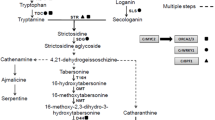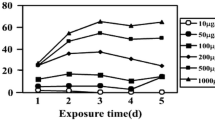Abstract
We studied the photooxidative effects of methyl viologen (MV) on PSII in rice (Oryza sativa L). Leaves were held at either room temperature (RT) or 4°C. In the presence of MV, the photochemical efficiency of PSII, or Fv/Fm, was more depressed at RT than at the low temperature (LT), but the loss of D1 protein that was detected at RT was not observed at LT. However, the decline in the content of functional PSII, 1/Fo - 1/Fm, was similar for MV-treated leaves at either temperature. These results suggest that, at LT, PSII is not protected from MV-induced photooxidation, although degradation of the D1 protein is delayed. The 1/Fo - 1/Fm decreased by MV treatment at RT was significantly recovered during dark incubation for 2 h. Recovery of a small portion of 1/Fo - 1/Fm was also possible, even for tissues treated with MV at LT. Therefore, we believe that MV-induced reversible photoinactivation may exist This possibility is further discussed in terms of changes in the de-epoxidation state and the rate of PSII-driven electron transport.
Similar content being viewed by others
Literature cited
Arnon DI (1949) Copper enzymes in isolated chloroplasts. Polyphenoloxidase in Beta vulgaris. Plant Physiol24:1–15
Aro E-M, Hundal T, Garlberg I, Andersson B (1990) In vitro studies on light-induced inhibition of photosystem II and D1-protein degradation at low temperatures. Biochem Biophys Acta1019: 269–275
Aro E-M, McCaffery S, Anderson JM (1993) Photoinhibition and D1 protein degradation in peas acclimated to different growth irradiances. Plant Physiol103: 835–843
Asada K, Takahashi M (1987) Production and scavenging of active oxygen in photosynthesis, In DJ Kyle, CB Osmond, CJ Arntzen, eds, Photoinhibition, Elsevier, Amsterdam, 227–287
Bowler C, van Camp W, van Montagu M, Inzé D (1994) Superoxide dismutase in plants. Crit Rev Plant Sci13: 199–218
Brüggemann W, Linger P (1994) Long-term chilling of young tomato plants under low light. IV. Differential responses of chlorophyll fluorescence quenching coefficients in Lycopersicon species of different chilling sensitivity. Plant Cell Physiol35: 585–591
Brüggemann W, van der Kooij TAW, van Hasselt PR (1992) Long-term chilling of young tomato plants under low light and subsequent recovery. II. Chlorophyll fluorescence, carbon metabolism and activity of ribulose-1,5-bisphosphate carboxylase/oxygenase. Planta186: 179–186
Büch K, Stransky H, Bigus HJ, Hager A (1994) Enhancement by artificial electron acceptors of thylakoid lumen acidification and zeaxanthin formation. J Plant Physiol144: 641–648
Byrd G, Ort DR, Ogren WL (1995) The effects of chilling in the light on ribulose-1,5-bisphosphate carboxylase/oxygenase activation in tomato (Lycopersicon esculentum Mill.). Plant Physiol107: 585–591
Dodge AD (1971) The mode of action of the bipyridylium herbicides, paraquat and diquat. Endeavor30: 130–135
Eu Y-J, Ha S-B, Lee C-H (1996) Effects of chilling injury in the light on chlorophyll fluorescence and D1 protein turnover in cucumber and pea leaves. J Biochem Mol Biol29: 398–404
Fujii T, Yokoyama E, Inoue K, Sakurai H (1990) The sites of electron donation of photosystem I to methyl viologen. Biochim Biophys Acta1015: 41–48
Genty B, Briantais JM, Baker NR (1989) The relationship between the quantum yield of photosynthetic electron transport and quenching of chlorophyll fluorescence. Biochim Biophys Acta90: 87–92
Gilmore AM, Yamamoto HY (1991) Resolution of lutein and zeaxanthin using a nonencapped, lightly carbon-loaded C-18 high-performance liquid Chromatographic column. J Chromatogr543: 137–145
Kim J-H, Hwang HJ, Park H-S, Lee CB, Kwon YM, Lee C-H (1997) Differences in the rate of dephosphorylation of thylakoid proteins during dark incubation after chilling in the light between two rice (Oryzasativa L.) varieties. Plant Sci128: 159–168
Kim S-J, Lee C-H, Hope AB, Chow WS (2001) Inhibition of photosystem I and II and enhanced back flow of photo-system I electrons in cucumber leaf discs chilled in the light. Plant Cell Physiol42: 842–848
Ottander C, Hundal T, Andersson B, Huner NPA, Öquist G (1993) Photosystem II reaction centres stay intact during low temperature photoinhibition. Photosynth Res35: 191–200
Pfündel EE, Bilger W (1994) Regulation and possible function of the violaxanthin cycle. Photosynth Res42: 89–109
Preston C (1994) Resistance to photosystem I disrupting herbicides, In SB Powles, JAM Holtum, eds, Herbicide Resistance in Plants: Biology and Biochemistry, Lewis Publishers, Boca Raton, FL, 61–82
Rintamäki E, Kettunen R, Aro E-M (1996) Differential D1 dephosphorylation in functional and photodamaged photosystem II centers. J Biol Chem271: 14870–14875
Rintamäki E, Salo R, Lehtonen E, Aro E-M (1995) Regulation of D1-protein degradation during photoinhibition of photosystem II in vivo: Phosphorylation of the D1 protein in various plant groups. Planta195: 379–386
Sassenrath GF, Ort DR, Portis AR Jr (1990) Impaired reductive activation of stromal bisphosphatases in tomato leaves following low-temperature exposure at high light. Arch Biochem Biophys282: 302–308
Sonoike K (1996) Degradation of psaB gene product, the reaction center subunit of photosystem I, is caused during photoinhibition of photosystem I: Possible involvement of active oxygen species. Plant Sci115: 157–164
Thiele A, Krause GH (1994) Xanthophyll cycle and thermal energy dissipation in photosystem II: Relationship between zeaxanthin formation, energy-dependent fluorescence quenching and photoinhibition. J Plant Physiol144: 324–332
Xu CC, Jeon YA, Lee C-H (1999) Relative contributions of photochemical and non-photochemical routes to excitation energy dissipation in rice and barley illuminated at a chilling temperature. Physiol Plant107: 447–453
Author information
Authors and Affiliations
Corresponding author
Rights and permissions
About this article
Cite this article
Kim, JH., Lee, CH. Mechanism for photoinactivation of PSII by methyl viologen at two temperatures in the leaves of rice (Oryza sativa L.). J. Plant Biol. 46, 10–16 (2003). https://doi.org/10.1007/BF03030295
Received:
Accepted:
Issue Date:
DOI: https://doi.org/10.1007/BF03030295




